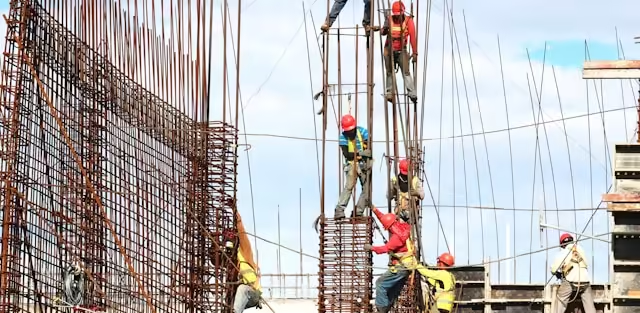The construction industry is being transformed by technology, with AI in construction industry leading innovations. From enhancing project management to boosting safety, AI-driven tools are reshaping how construction companies operate.
In this guide, we’ll explore the key AI-powered solutions driving change in construction and what you need to know to stay competitive.
1. How AI in Construction Industry Uses Predictive Analytics for Project Management
AI-based predictive analytics is revolutionising project management in construction. With so many moving parts and variables, even minor setbacks can delay timelines and inflate costs. Predictive analytics algorithms help project managers anticipate risks and proactively address potential issues.
- Real-Time Insights: AI algorithms analyse vast data sets from past projects, weather patterns, and on-site data, enabling predictive models that improve scheduling and budget estimations.
- Risk Management: By identifying high-risk areas, predictive analytics helps companies allocate resources effectively and mitigate potential delays or cost overruns.
Example: AI-driven software could flag a potential weather-related delay, allowing project managers to adjust timelines and resource allocation to avoid disruptions.
2. AI-Driven Design and Planning Tools
Planning and design in construction often require repetitive tasks and complex calculations that are time-intensive and susceptible to human error. AI-powered design tools automate much of this process, enabling architects, engineers, and planners to streamline workflows.
- Generative Design: AI-based generative design tools create multiple design iterations based on specific parameters, such as site restrictions, material limitations, and budget constraints. Users can then select the most feasible options.
- BIM (Building Information Modelling): Advanced BIM tools with AI integration provide real-time 3D modelling and simulations, allowing for more accurate visualisations and faster decision-making.
Example: Using an AI-enhanced BIM tool, architects and engineers can simulate the entire construction process, testing different designs and materials for efficiency and sustainability before breaking ground.
3. The Role of Robotics in AI in Construction Industry
AI-powered robotics are transforming on-site construction by handling repetitive and hazardous tasks, increasing both safety and productivity. Robotics integrated with AI can perform complex tasks such as bricklaying, concrete pouring, and even welding, with a high level of precision.
- Automated Machinery: Autonomous machinery such as bulldozers, cranes, and trucks are increasingly being used on construction sites. AI enables these machines to follow detailed instructions, minimising human error.
- Quality Control: Robotics equipped with computer vision can inspect materials and work quality, identifying issues that may go unnoticed by human inspectors.
Example: A construction company can use robotic bricklayers, allowing skilled labour to focus on complex tasks while automating repetitive work, saving time and reducing error.
4. Enhanced Safety with AI-Powered Monitoring
Construction sites are among the most hazardous workplaces. AI-powered safety monitoring solutions use computer vision and real-time data analysis to improve safety protocols and minimise accidents.
- Wearables and Sensors: AI can be integrated with wearable devices that monitor workers’ vital signs and movement, detecting unsafe behaviours such as entering restricted zones.
- Computer Vision for Site Surveillance: Computer vision cameras monitor construction sites and detect potential hazards, such as spills, unsafe equipment usage, or workers without proper protective gear.
Example: AI-based software can detect when a worker isn’t wearing a helmet or entering an unsafe area, immediately alerting site managers to prevent accidents.
5. Supply Chain Optimisation
Efficiently managing materials and supply chain logistics is critical to the success of construction projects. AI-powered solutions help streamline procurement, inventory, and delivery management, allowing companies to avoid delays caused by material shortages or logistical issues.
- Demand Forecasting: AI can forecast material needs based on historical data, current market trends, and project requirements, ensuring optimal inventory levels.
- Automated Ordering: By predicting material needs, AI solutions can automate the ordering process, ensuring that supplies are available just in time without overstocking or running out.
Example: A construction firm using AI for supply chain optimisation can reduce waste by ensuring materials arrive exactly when needed, reducing storage costs and avoiding spoilage.
6. Environmental Impact and Sustainability Analysis
AI can play a crucial role in enhancing sustainability in the construction industry. By using AI to analyse the environmental impact of different building materials and construction methods, companies can make more informed decisions that align with sustainability goals.
- Material Selection: AI tools help evaluate the environmental footprint of materials, suggesting eco-friendly alternatives without compromising quality or budget.
- Energy Efficiency Modelling: AI-driven simulations can analyse how different building designs impact energy use, helping companies construct buildings with optimal energy efficiency.
Example: A developer could use AI-driven energy modelling to predict a building’s carbon footprint, allowing them to adjust the design to maximise energy efficiency and meet regulatory standards.
7. Real-Time Quality Control and Maintenance
AI solutions enhance quality control during construction and facilitate predictive maintenance post-construction. By monitoring conditions and potential weak points, these systems help detect defects early, reducing the need for costly repairs later on.
- Defect Detection: Computer vision and machine learning algorithms identify defects in real-time, allowing builders to correct issues immediately.
- Predictive Maintenance: AI can predict when maintenance will be required for structures and infrastructure, ensuring timely repairs and reducing downtime.
Example: An AI-based quality control system can alert engineers to defects in concrete pouring, enabling on-the-spot corrections before the material fully hardens.
Final Thoughts: AI as a Construction Industry Game Changer
As the construction industry adopts AI solutions, companies that embrace these technologies are likely to gain a competitive edge. AI not only enhances efficiency and safety but also provides a platform for innovation and growth, helping businesses build smarter, safer, and more sustainable structures. From predictive analytics to autonomous machinery, the potential of AI to reshape construction is immense.
For construction firms, understanding and implementing AI technologies isn’t just about staying current—it’s about future-proofing the business in an industry increasingly driven by data and digital transformation. Now is the time to explore AI-powered tools and strategies that align with your business goals and operational needs. AI may just be the key to building not only impressive structures but a resilient, scalable, and forward-thinking business.
If you’re curious about how AI is transforming other facets of the built environment, don’t miss our article on “7 Ways AI is Changing the Future of Property Development”.




1 Comment
How Data Analytics Transforms Construction: Efficiency, Safety, and Profitability - CJ Advisory
[…] For more on how technology is reshaping the construction industry, check out our blog on AI in Construction Industry: Innovations You Need to Know. […]